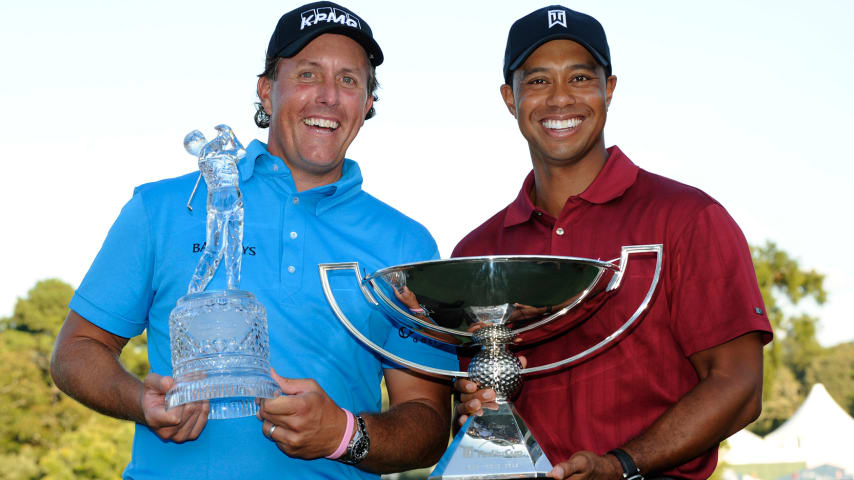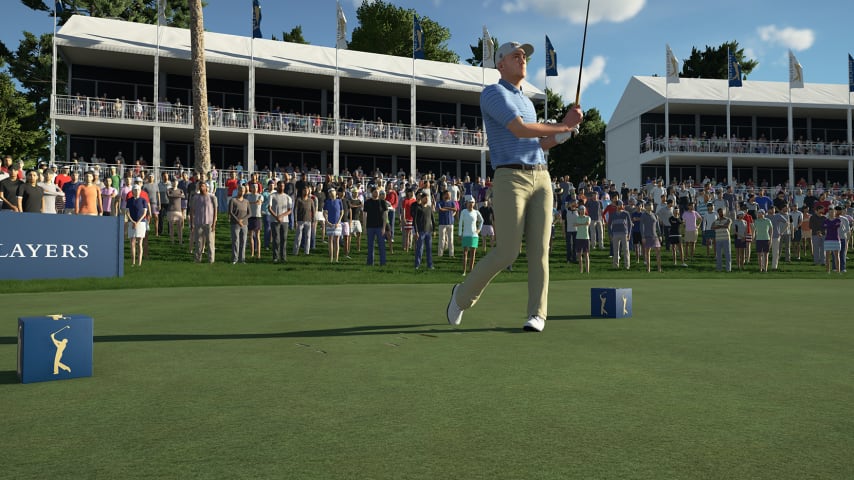Art vs. science: Q&A with ‘Golf’s Holy War’ author
5 Min Read

BRIGG, ENGLAND - OCTOBER 06: A shadow of a player is shown during Day One of the Skins PGA Fourball Championships Final at Forest Pines Hotel & Golf Resort on October 6, 2010 in Brigg, England. (Photo by Tom Dulat/Getty Images)
Written by Sean Martin
We live in an advanced age where science and technology have given us a deeper understanding of the world around us. Science can’t answer every question, though, and when it falls short, people often flock to the transcendent. That’s true in life, and in golf. Such a dichotomy is apparent in an age of Trackman and analytics. Some lean on math and science in their quest to conquer the unconquerable game. Others take a more artistic approach.
Can the two sides coexist? That’s the question that Brett Cyrgalis tackles in his book, “Golf’s Holy War,” released this month. We spoke to Cyrgalis to learn more about his book and his views on the current state of the game.
PGATOUR.COM: The book’s title implies conflict. Do you see competing factions in the game?
BRETT CYRAGALIS: There’s a conflict there between thinking you can know everything and knowing that … there’s more to the game than just the data. That’s really where the conflict is.
There’s two works that show these two factions. One is “The Golfing Machine,” which is like this super-technical book that Bryson DeChambeau aligns himself with. And there’s “Golf In The Kingdom,” which is this very weird, mystical, semi-fictional book written by Michael Murphy who started a consciousness camp on the shores of Big Sur. People attach themselves to science and want to be objective, but there is this longing and (“Golf In The Kingdom”) resonates a lot more with people.
It comes down to what makes you love the game? It’s probably not having your elbow in the perfect position. It’s probably seeing the grass and smelling the ocean and enjoying your time.
This isn’t meant to poo-poo science and data. They’re very useful. The more information and knowledge you have, it’s good. But that doesn’t necessarily make you a better player. And for almost everybody in the world, you’re not trying to make a living playing golf. You’re trying to enjoy yourself.
PGATOUR.COM:There are two characters from your book that I want to talk about. The first is Michael Murphy. Tell us about him and the time you spent with him.
CYRAGALIS: Michael Murphy is as interesting as you imagine. He’s tall and broad-shouldered. When I met him, he was 82, but he looked like he was in his late 60s. He has this intelligence that you can’t avoid. And he’s funny and irreverent, but he has such a strong belief in the mystical that he kind of drops little hints every now and then.
He told me that he thought Tiger Woods had a shamanistic gift and how he had this transcendent moment watching Tiger Woods at The Honda Classic one year, and how he thinks watching Tiger is like watching Frodo Baggins on his journey and he can’t get enough of it.
He had this spiritual awakening when he was at Stanford, and he decided that he wanted to study at a Hindu ashram in India and on his way he was going to play a round of golf. And so he stopped in St. Andrews and played a round of golf and went on his way. In the book, he tells the same story of a guy named Michael Murphy, who is traveling to India but stopped to play golf in Scotland. He plays a course called Burningbush, and he bumps into a teacher and a student, and the teacher is giving a lesson in golf mysticism. He sees orbs floating around the ball and talks about how to channel your inner game, in a Hindu, spiritual, religious kind of way.
It’s a weird book. It sounds weirder to explain it than to read it. It’s connected with so many people. Clint Eastwood bought the movie rights. Murphy is a character and the book, I think it’s seminal in the game.
PGATOUR.COM:And tell us about Sam Byrd, the former Yankee who had a hand in the modern golf swing.
CYRAGALIS: Sam Byrd played for the Yankees in the early ‘30s. He was known as “Babe Ruth’s Legs” because he would come in and replace Babe Ruth late in games. He was a great golfer. Bobby Jones said he was the best driver of the golf ball he’d ever seen. He ended up turning pro and (winning six times on the PGA TOUR).
I found this story because when I started asking about the first player on the PGA TOUR to really use a coach, it went back to this guy Mac McLendon. He was a good player out of college, but he didn’t think he hit it far enough and got all fouled up. So, he was looking for answers and he went to see Jimmy Ballard. Jimmy taught Mac McLendon and Mac became a good player and won a couple times on TOUR.
So everyone started going to Jimmy Ballard, like Curtis Strange and Sandy Lyle. But Jimmy Ballard goes back to Sam Byrd because Sam ran a driving range and a young Jimmy Ballard worked there. This was the beginning of the drill of putting the headcover under the lead arm. It used to be a very common sight on driving ranges. That goes back to Sam Byrd because Sam said that when he was called up to the Yankees, Babe Ruth told him to put a handkerchief under his arm when he swung. That was the idea of connection.
When Hogan saw Byrd play in the PGA Championship, he went up to him after that and said, “What do you know about putting a stick on a ball that no one else does?”
PGATOUR.COM:So, who wins this war?
CYRAGALIS: I don’t think a side wins. I think the answer is in the middle ground. Now that all the science is so prolific and everyone has their hands on it and sees it, it’s not proprietary info anymore. Every teacher needs to know a little bit of this stuff.
I think the next wave is about figuring out how your student learns. You need all of this info in your head. You need to know how all this stuff works, but then you need to know how to say it to the student, so they become better. It’s a fascinating idea because golf is this weird, esoteric game with this history, and it’s in a really interesting place right now.












